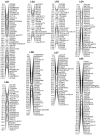A consensus linkage map of oil palm and a major QTL for stem height
- PMID: 25648560
- PMCID: PMC4316154
- DOI: 10.1038/srep08232
A consensus linkage map of oil palm and a major QTL for stem height
Abstract
Oil palm (Elaeis guinensis Jacquin) is the most important source of vegetable oil and fat. Several linkage maps had been constructed using dominant and co-dominant markers to facilitate mapping of QTL. However, dominant markers are not easily transferable among different laboratories. We constructed a consensus linkage map for oil palm using co-dominant markers (i.e. microsatellite and SNPs) and two F1 breeding populations generated by crossing Dura and Pisifera individuals. Four hundreds and forty-four microsatellites and 36 SNPs were mapped onto 16 linkage groups. The map length was 1565.6 cM, with an average marker space of 3.72 cM. A genome-wide scan of QTL identified a major QTL for stem height on the linkage group 5, which explained 51% of the phenotypic variation. Genes in the QTL were predicted using the palm genome sequence and bioinformatic tools. The linkage map supplies a base for mapping QTL for accelerating the genetic improvement, and will be also useful in the improvement of the assembly of the genome sequences. Markers linked to the QTL may be used in selecting dwarf trees. Genes within the QTL will be characterized to understand the mechanisms underlying dwarfing.
Figures



References
-
- Corley R. H. V. & Tinker P. [The origin and development of the oil palm insustry]. The oil palm [Corley, R. H. V. & Tinker, P. (ed.)][1–26] (John Wiley & Sons, Oxford, 2003).
-
- Corley R. & Lee C. The physiological basis for genetic improvement of oil palm in Malaysia. Euphytica 60, 179–184 (1992).
-
- Corley R. Potential productivity of tropical perennial crops. Exp Agric 19, 217–237 (1983).
Publication types
MeSH terms
LinkOut - more resources
Full Text Sources
Other Literature Sources

